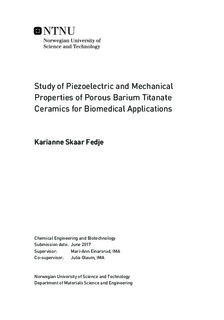| dc.description.abstract | Throughout the last decades, the development of bioactive materials to be used as bone implants has been a very active research area. The number of surgeries related to bone implants are steadily increasing, such that improvements in this field are for the benefit of more and more people. However, bone implants used today require long recovery time and aseptic loosening is a commonly occurring issue.
By using an active material with the ability to mimic the natural mechanisms of bone regeneration, the healing process might be improved and the recovery time decreased.
The mechanisms of bone regeneration are rather complex and involve, among other factors, the response of bone forming cells to mechanical triggers and electrical stimuli.
The bone regeneration is activated by an electric potential occurring in the bones upon application of a mechanical stress, similar to the piezoelectric effect.
Recent investigations of porous implant materials shows that large, interconnected pores allow ingrowth of vascularized cells, and hence increase the interface stability between the bone and the implant.
Barium titanate (BT}) has been suggested as a potential implant material, due to its biocompatibility, piezoelectricity and mechanical properties. However, as the mechanical and piezoelectric properties decrease with increasing porosity, it is of interest to investigate how these relationships change depending on porosity.
Porous samples of BT were made through the sacrificial template method, using corn starch and poly(methylmethacrylate) (PMMA) as pore formers. The phase purity and microstructure of the samples was characterized by X-ray diffraction (XRD) and scanning electron microscopy (SEM).
The piezoelectric coefficient, describing the electrical response of the material to a mechanical stimulus and vice versa, was determined on electrically poled samples. The microhardness of the samples was investigated by Vikers' indentation measurement.
In order to estimate how the material retains its piezoelectric and mechanical properties within the body, the properties were measured prior and subsequent to soaking in 0.9% NaCl-solution for 14 days.
Samples made with both pore formers resulted in a homogeneous pore distribution. The samples made with PMMA showed promising qualities in terms of porosity control and piezoelectric properties at porosities up to ~55 vol% of the total volume of the pellet. Interconnected pores within the desired size range were obtained at a porosity of 50 vol% added PMMA, whereas for corn starch the desired pore size was not observed until addition of 80 vol% pore former. The hardness was higher for the samples made from corn starch. However, as the hardness measurements were difficult to conduct, further investigation of the mechanical properties, through nanoindentation or uniaxial compression testing is suggested. | |

